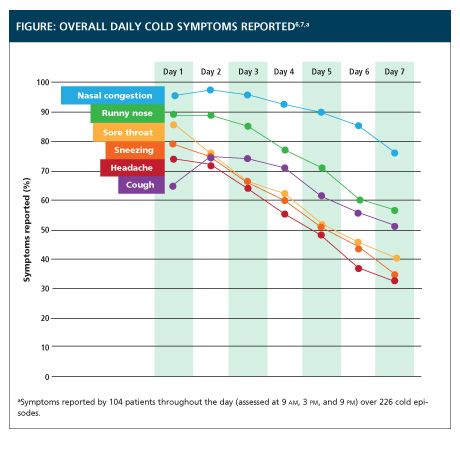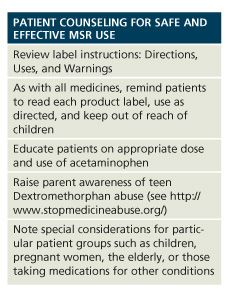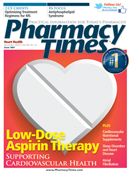Publication
Article
Pharmacy Times
Role of Multi-Symptom OTC Self-Care Products for Cold & Flu Symptom Relief
This article was sponsored by Procter & Gamble.
Acute, viral upper respiratory tract infections (URTIs), which include the common cold and influenza, are among the most common and widespread illnesses worldwide, affecting adults an average of 2 to 4 times per year.1 Although the symptoms associated with URTIs are self-limited, these viral illnesses are responsible for loss of productivity2,3 and high health care costs.4
Based on self-identified symptoms, patients may choose to treat with OTC medicines. Because of the seemingly overwhelming variety of cold and flu products available, patients will often seek their pharmacist’s guidance regarding which products are appropriate to address their various symptoms. Based on responses from a US-based survey, it has been estimated that pharmacists make more than 2 million “cough, cold and flu combination product” recommendations per month.5 Because they are among the most accessible and most trusted health care providers, pharmacists can counsel patients on the appropriate nonprescription medicine to help relieve the multiple, concurrent symptoms typically experienced in the first days of a cold or flu.

Cold and Flu: Multiple, Concurrent Symptoms
To understand how symptoms present during a URTI, Vicks, the makers of NyQuil and DayQuil, conducted a prospective cold surveillance study among employee volunteers.6 Data were gathered on community-acquired cold illness episodes over a 4-year period. The study is unique because the majority of subjects were enrolled within 24 hours of the start of cold symptoms. Self-reported cold symptoms over the first 7 days are shown in the Figure.6,7 Nasal congestion was the predominant symptom, peaking on day 2 with 90% or more of cold episodes characterized by the presence of this symptom throughout the day for the first 5 days. The persistence of certain symptoms throughout the cold was evident by the fact that nasal congestion, cough, and runny nose continued to be reported in 51% or more of cold episodes at day 7.

Rationale for Using Multi-Symptom Relief Products
Although cold and flu illnesses are self-limited and gradually resolve within 7 to 10 days, the symptoms can nonetheless be unpleasant, bothersome, and disruptive to everyday life and activities. Patients can choose to: 1) forego treatment, 2) select individual single-active ingredient products for concurrent use, or 3) purchase a product containing multiple active ingredients (ie, multiple symptom relief [MSR] or fixed-dose combination products). A well-accepted approach is to treat the particular symptom the patient reports at the time of consultation.8 This may help patients to avoid taking unnecessary active ingredients in an MSR product, or inadvertently taking multiple doses of acetaminophen from various medicines they may be using to treat different conditions.
However, as the typical cold and flu manifest with concurrent symptoms, it is appropriate to consider MSR products that relieve several symptoms simultaneously by combining appropriate active ingredients. According to the World Health Organization (WHO) Expert Committee Report on fixed-dose combination medicinal products, such products have potential advantages over single-ingredient medicinal products, including9:
- Better patient adherence (based on anecdotal reports)
- Lower cost
- Simplified logistics of procurement and distribution
- Convenience for prescribers and patients
Similarly to WHO, the FDA takes the following position with regard to fixed-dose combination products10:
“An OTC drug may combine 2 or more safe and effective active ingredients…when the combination, when used under adequate directions for use and warnings against unsafe use, provides rational concurrent therapy for a significant proportion of the target population.”
Daytime and Nighttime Multi-Symptom Relief Options
When recommending the appropriate product for patients among available daytime or nighttime multi-symptom relief cold and flu products, the impact of patient preference is useful to consider. A consumer survey showed that patients choose to treat their symptoms with a cold and flu medicine so they can carry on with their daily routine at home (79%) or work (53%).11 Patients also reported that they seek symptom relief to help them get a good night’s sleep (81%).11 According to a separate, recent survey of adults who have used a cough, cold, or flu product in the past 24 months, patients prefer to use NyQuil for nighttime cough, cold, and flu symptoms versus leading brands, and DayQuil for non-drowsy relief of cough, cold, and flu symptoms versus leading brands (based on top brands from September, 2014, among those who expressed a preference).12
Role of the Pharmacist
OTC cough, cold, and flu medicines provide patients with convenient, cost-effective symptom relief that can help reduce the number of physician visits. MSR products provide a rational treatment approach to help relieve the multiple symptoms that present concurrently in the first days of illness. Options that are appropriate for the time of day may also help address the patient’s needs and treatment preferences. Patients are often overwhelmed and confused by the array of choices available on the shelf and frequently seek their pharmacist’s help in selecting the right product to treat their symptoms. Community pharmacists are a trusted source of information and in a unique position to help patients make the right choice through product recommendation and patient counseling for safe and effective product use.
References
- Heikkinen T, Jarvinen A. The common cold. Lancet. 2003;361(9351):51-59.
- Bramley TJ, Lerner D, Sames M. Productivity losses related to the common cold. J Occup Environ Med. 2002;44(9):822-829.
- Nichol KL, D’Heilly S, Ehlinger E. Colds and influenza-like illnesses in university students: impact on health, academic and work performance, and health care use. Clin Infect Dis. 2005;40(9):1263-1270.
- Fendrick AM, Monto AS, Nightengale B, Sarnes M. The economic burden of non-influenza-related viral respiratory tract infection in the United States. Arch Intern Med. 2003;163(4):487-494.
- Pharmacy Times OTC Guide. Cough, Cold and Allergy: Daytime. http://www.otc guide.net/conditions/coughcoldallergy/cough-cold-flu-combinations-daytime. Nighttime. http://www.otcguide.net/conditions/coughcoldallergy/cough-cold-flu-combinations-nighttime. Accessed November 2014.
- Procter & Gamble. Data on file. Study #87-213.
- Witek TJ, Cohen SD, Geist FC, et al. The clinical course of acute upper respiratory infection. Paper presented at: XIV Congress of the European Rhinologic Society/XI International Symposium on Infection and Allergy of the Nose; October 6—10, 1992; Rome, Italy. Abstract 144.
- Scolaro KL. Disorders related to colds and allergy. In: Krinsky DL, Berardi R, Ferreri S, et al, eds. Handbook of Nonprescription Drugs. 17th ed. Washington, DC: American Pharmacists Association; 2012:178-201.
- WHO Expert Committee on Specifications for Pharmaceutical Preparations. Thirty-ninth Report: Annex 5, Guidelines for registration of fixed-dose combination medicinal products. WHO Technical Report Series, No. 929, 2005.
- US Code of Federal Regulation. 21 CFR §330.10(a)(4)(iv). Procedures for classifying OTC drugs as generally recognized as safe and effective and not misbranded, and for establishing monographs. http://www.accessdata.fda.gov/scripts/cdrh/cfdocs/cfcfr/CFRSearch.cfm?fr=330.10. Revised April 1, 2014. Accessed November 21, 2014.
- Procter & Gamble. Data on file. Study #US-10D863.
- Procter & Gamble. Data on file. Study #US-148687.







